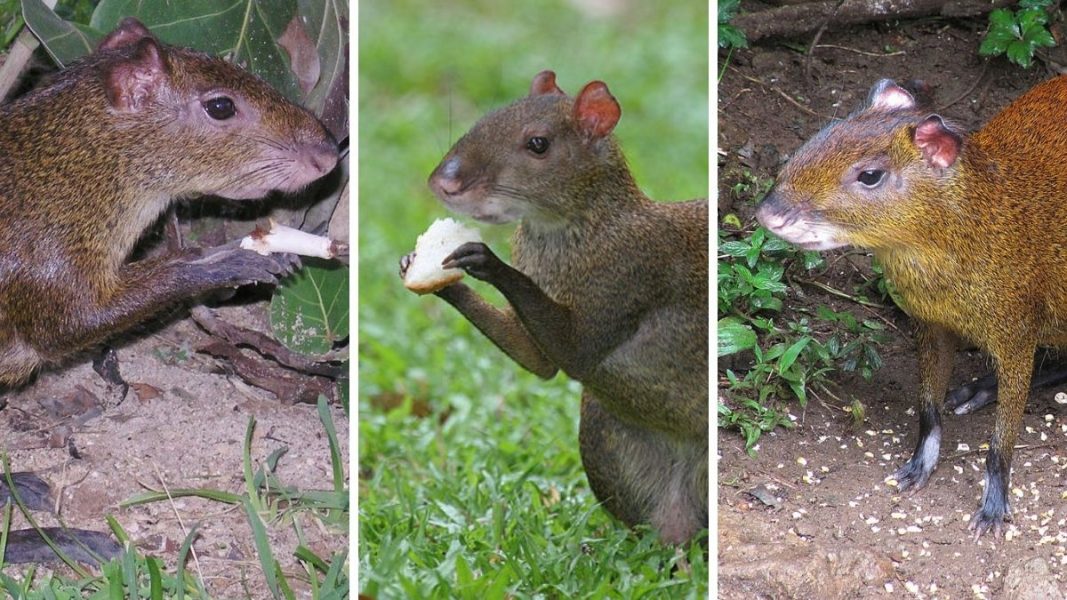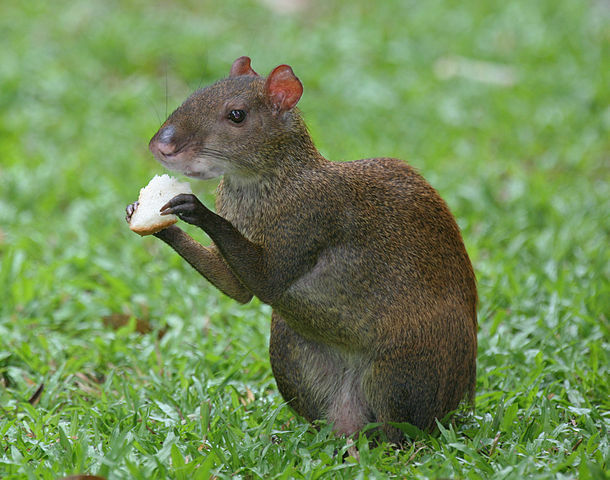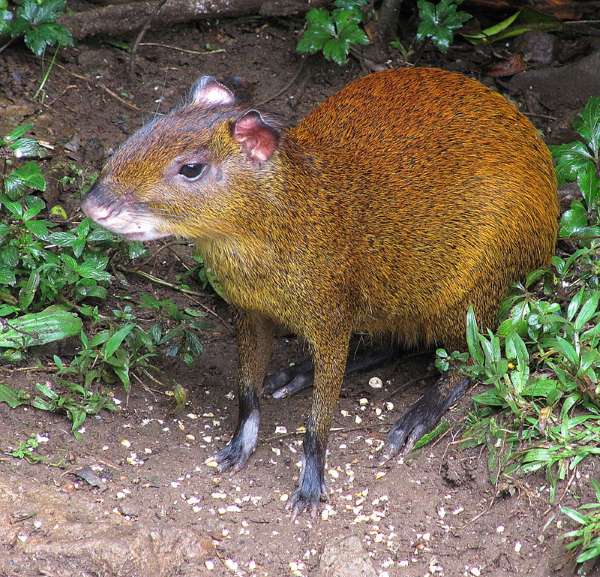
The Agouti is a wild rodent mammal belonging to the genus Dasyprocta sp. that lives in the tropical rainforests of the Amazon region, whose game meat is highly prized in local communities and in Latin America in general. This explains why the species of this genus are heavily depredated or persecuted with a high hunting pressure. Therefore, in the Peruvian, Ecuadorian and Brazilian Amazon, one of the most frequently hunted species is the Agouti, followed by peccaries and armadillos (Mayor, et al., 2007) (3).
Taxonomy of agouti
The Añuje belongs to the kingdom Animal; order Rodentia; suborder Hystricognathi; family Dasyproctidae and genus Dasyprocta. The taxonomic classification of this genus basically includes eleven species, among them we can highlight: Dasyprocta agouti, Dasyprocta fuliginosa, Dasyprocta vane gata, Dasyprocta azarae and Dasyprocta prymnolopha (Mayor, et al., 2007) (3).
Common names of agouti
According to Tapia (1997) (4), the Agouti has many common names, as many as could be found in a calendar. For example, in Brazil it is known as Cotia or Cutiapreta; Añuje in Peru; Picure or Acure in Venezuela; Guatusa in Ecuador and Costa Rica; Jochi Colorado in Bolivia; Agutí, Guatín, Picure, Conejo Negro and Ñeque in Colombia; North Americans call it Black Agouti. On the other hand, in some indigenous communities of the Ecuadorian Amazon, the Quichuas call it Punllana or Sicu; the Shuar and Achuar call it Kayuk; the Cofanes call it Quiya and the Secoyas refer to this animal as Hue.

Geographic distribution of the agoutis
Agouti is native to South America and is distributed throughout its geographic range, with an altitudinal range from sea level to 2,000 m (6,000 ft). It is found in countries such as Peru, Ecuador, Colombia, Brazil, Bolivia, Venezuela, Panama and Costa Rica (Tapia, 1997) (4).
According to Mayor, et al. (2007) (3), the most widely distributed species is Dasyprocta punctata which is found throughout Central America, the Andean region and as far north as Argentina. Dasyporcta fuliginosa is located in the north of the Amazon region; Dasyprocta leporina in the eastern Amazon region (mainly in Venezuela and Brazil); and Dasyprocta azare located in the northernmost regions such as Paraguay, southern Brazil and northeastern Argentina.
Habitat
This rodent mammal is commonly found in tropical and subtropical areas, preferring wooded areas and regions surrounded by streams, where there is edible fruit-producing flora; they are often found on the banks of streams, lakes and rivers. Generally, the Agouti establishes its burrows under fallen trees, inside old trunks, in the middle of large stones or in shallow abandoned caves (Campos, 2009) (2).

Description of agouti
It is a rodent that weighs between 3.5 and 5 kg and its size varies between 50 and 65 cm, depending on the species; it has a small tail of approximately 1 cm. Its coat has a variety of shades ranging from black, reddish brown and yellowish. It has long, slender limbs, large haunches and a hunched back. The feet of animals of the genus Dasyprocta are brown in color; the forelimbs have four strong toes and the hind limbs have three long toes with sharp, hoof-like nails that allow them to dig with ease. They have sharp teeth that allow them to break nut shells (Mayor, et al., 2007) (3).
Feeding
The Añuje is considered an omnivorous species as it feeds mainly on fruits, seeds, nuts, leaves, roots, grasses, wild flowers, tubers and small vertebrates. They also tend to bury nuts and reserve seeds (Mayor, et al., 2007) (3).
Behavior of the vintage
This wild rodent is diurnal, agile, gentle and very observant. A curiosity of these animals is that when they feed they always sit down, keeping their bodies straight on their strong hind legs, holding the food between their front legs – just like the squirrel – and always on the lookout for any possible threat. When they feel they are being stalked, they can reach great speed in their movements. Their life expectancy is around 12 years, but in captivity – outside their natural habitat – they can last a few years longer (Aguilar, 02/26/2018) (1).
The mating of these animals can occur at any time of the year. The female has two births per year, each of two young (sometimes three and four), and gestation lasts 98 to 110 days. They are monogamous and therefore remain with the same partner for life (Campos, 2009) (2).

Main domesticated species
Although it is possible to domesticate the Agouti, its natural habitat is the forest. The main species of this animal that have been bred are: Dasyprocta fuliginosa, which is a native Amazonian species, with two breeds, one more black and the other more silvery; and Dasyprocta punctata located in the western area of the Andes, with brownish, brown, reddish or yellowish coloration. However, it is recommended not to mix both species in the same hatchery, as this would hinder efficient reproduction (Tapia, 1997) (4).
Nutritional value of agave meat
According to Tapia (1997) (4), Agouti meat has an excellent flavor and a higher nutritional value compared to other common meats for human consumption. It is rich in protein (27.7%), low in fat (2.39%) and high in fiber (0.30%), which facilitates digestion.
In relation to the price of meat from other animals, such as chicken, beef or lamb, Añuje meat can be marketed at a higher average price. The viscera, blood and bones are also used for human consumption, or are used in the production of animal feed and concentrates. Since pre-Hispanic times it has been used as food and its meat is considered delicious. Thus, the Shuar Indians of Ecuador traditionally prepare Guatusa broth; they can also cook stewed or “sweaty” Agouti, or grilled Añuje, among other recipes (Tapia, 1997) (4).
References
- Aguilar, M. (26/02/2018). Do you know the Agouti? Retrieved from https://www.muyinteresante.es/mascotas/fotos/conoces-al-aguti
- Campos, G. (2009). Reference values of serum urea and creatinine in añujes (Dasyprocta fuliginosa) kept in captivity at the Parque de las Leyendas Zoo. Lima: Universidad Nacional Mayor de San Marcos. Retrieved from http://cybertesis.unmsm.edu.pe/bitstream/handle/20.500.12672/3128/Campos_ng.pdf?sequence=1&isAllowed=y
- Mayor, P., Santos, D., and López, M. (2007). The sustainability of the Amazon and wild animal husbandry. Iquitos: Centro de Estudios Teológicos de la Amazonía. Retrieved from https://www.midagri.gob.pe/portal/download/pdf/direccionesyoficinas/dgca/crianza/sostenibilidad_animales_silvestres.pdf
- Tapia, M. (1997). Guide for the management and breeding of the “Agouti”, “Picure”, “Guatusa”, or “Ñeque”. Dasyprocta punctata Gray and Dasyprocta fuliginosa Wagler. Retrieved from https://repository.agrosavia.co/handle/20.500.12324/29570
This post is also available in:
![]() Español (Spanish)
Español (Spanish)
